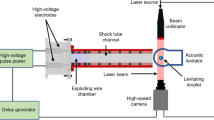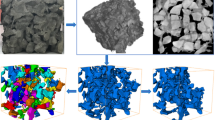Abstract
Supercritical drying avoids capillary forces, but damaging stresses can be generated during solvent exchange, pressurization, and depressurization. Each of those steps has been analyzed, so the duration of the process can be minimized without risk to the sample. This work, which was initiated in collaboration with Professor Jean Phalippou’s group, is reviewed. Poromechanics is the study of stresses and strains resulting from interaction of the solid and liquid phases in a porous material. For example, if a gel is immersed in another liquid for solvent exchange, the gel network may undergo a transient contraction if the original pore liquid diffuses out faster than the replacement liquid diffuses in; poromechanical analysis quantifies the resulting stresses and indicates whether there is a risk of cracking. In the preparation of aerogels, when the pressure in the autoclave is decreased, the higher pressure inside the aerogel causes it to expand, which may result in cracking. Poromechanics reveals the rate of depressurization that can be imposed without creating damaging stresses. We also show that the sensitivity of gels to pore pressure can be exploited to measure their permeability to gases and liquids by observing the response to small loads or changes in temperature.

A dilatometer incorporated into the autoclave measures dilatation of the gel during the supercritical drying cycle, and poromechanical analysis allows extraction of the permeability from the measured strain. Similar analyses are used to minimize the cycle time while avoiding damaging stresses during the solvent exchange, pressurization, and heating, and depressurization steps.
Highlights
-
Poromechanics quantifies supercritical drying stresses during solvent exchange, pressurization and heating, and depressurization.
-
Supercritical drying duration is minimized by accounting for the pressure dependence of permeability, viscosity and compressibility.
-
By monitoring strain of the aerogel during depressurization, permeability can be measured as a function of pressure.
-
The permeability of gels is found from their response to small loads or changes in temperature.












Similar content being viewed by others
References
Hdach H, Woignier T, Phalippou J, Scherer GW (1990) “Effect of aging and pH on the modulus of aerogels”. J Non-Cryst Solids 121:202–205
Pauthe M, Quinson JF, Hdach H, Woignier T, Phalippou J, Scherer GW (1991) Autoclave treatment effect on silica alcogel sructure. J Non-Cryst Solids 130:1–7
Woignier T, Phalippou J, Larnac G, Pernot F, Scherer GW (1992) Evolution of mechanical properties during the alcogel-aerogel-glass process. J Non-Cryst Solids 147&148:672–680
Alaoui AH, Woignier T, Phalippou J, Scherer GW (1998) Room temperature densification of aerogel by isostatic compression. J Sol-Gel Sci Technol 13:365–369
Duffours L, Woignier T, Phalippou J (1995) “Plastic behaviour of aerogels under isostatic pressure”. J Non-Cryst Solids 186:321–327
Woignier T, Quinson JF, Pauthe M, Repellin Lacroix M, Phalippou J, Scherer GW (1994) The sintering of silica aerogels studied by thermoporometry. J Sol-Gel Sci Technol 2:277–282
Scherer GW, Calas S, Sempéré R (1998) Densification kinetics and structural evolution during sintering of silica aerogel. J Non-Cryst Solids 240:118–130
Biot MA (1941) General theory of three-dimensional consolidation. J Appl Phys 12:155–164
Biot MA, Willis DG (1957) The elastic coefficients of the theory of consolidation. J Appl Mech 24:594–601
Coussy O (2004) Poromechanics. Wiley, West Sussex, England
Wang HF (2000) Theory of Linear Poroelasticity. Princeton Univ. Press, Princeton, NJ, p 287
Coussy O (2005) Poromechanics of freezing materials. J Mech Phys Solids 53:1689–1718
Sun Z, Scherer GW (2010) Effect of Air Voids on Salt Scaling. Cem Concr Res 40:260–270
Coussy O, Brisard S (2009) Prediction of drying shrinkage beyond the pore isodeformation assumption. J Mech Mater Struct 4(2):263–279
Scherer GW (2015) Drying, shrinkage, and cracking of cementitious materials. Transport Porous Med 110(2):311–331
Coussy O (2006) Deformation and stress from in-pore drying-induced crystallization of salt. J Mech Phys Solids 54:1517–1547
Flatt RJ, Caruso F, Aguilar Sanchez AM, Scherer GW (2014) Chemomechanics of salt damage in stone. Nat Commun 5:4823
Bear J (1972) Dynamics of fluids in porous media. American Elsevier, New York, NY
Scherer GW (2004) Characterization of saturated porous bodies. Concr Sci Eng 37:21–30
Scherer GW (1989) Drying gels: VII. Diffusion during drying. J Non-Cryst Solids 107:135–148
Scherer GW (1994) Stress in aerogel during depressurization of autoclave: I. theory. J Sol-Gel Sci Technol 3:127–139
Woignier T, Phalippou J, Hdach H, Scherer GW (1990) Mechanical properties of silica alcogels and aerogels. In: Zelinski BJJ, Brinker CJ, Clark DE, Ulrich DR eds. Better Ceramics Through Chemistry IV. Mat Res Soc, Pittsburgh, PA, p 1087–1099
M.P. Vukalovich, V.V. Altunin (1968) Thermophysical properties of carbon dioxide (Collet’s, London)
Zhang Z, Scherer GW (2017) Supercritical drying of cementitious materials. Cem Concr Res 99:137–154
Fabbri A, Corvisier J, Schubnel A, Brunet F, Goffé B, Rimmele G, Barlet-Gouédard V (2009) Effect of carbonation on the hydro-mechanical properties of Portland cements. Cem Concr Res 39:1156–1163
Penoncello SG, Lemmon EW, Jacobsen RT, Shan Z (2003) A fundamental equation for trifluoromethane (R-23). J Phys Chem Ref Data 32:1473–1499
H. Hdach (1992) Interaction liquide—solide dans les gels de silice: effet de la température, (Liquid-solid interaction in silica gels: effect of temperature), Doctoral thesis, Univ. Montpellier, France
Brinker CJ, Scherer GW (1990) Sol-Gel Science. Academic Press, New York, NY, Ch. 6
Scherer GW, Hdach H, Phalippou J (1991) Thermal expansion of gels: a novel method for measuring permeability. J Non-Cryst Solids 130:157–170. Erratum: J. Non-Cryst Solids 194 (1996) 326
Scherer GW (1992) Stress development during supercritical drying. J Non-Cryst Solids 145:33–40
Scherer GW, Swiatek RM (1989) Measurement of permeability: II. Silica Gel. J Non-Cryst Solids 113:119–129
Scherer GW (1994) Measuring permeability by the thermal expansion method for rigid or highly permeable gels. J Sol-Gel Sci Technol 3:31–40
Scherer GW (1989) Effect of shrinkage on modulus of silica gel. J Non-Cryst Solids 109:183–190
Scherer GW (1992) Bending of gel beams: method of characterizing mechanical properties and permeability. J Non-Cryst Solids 142:18–35
Scherer GW (2000) Measuring permeability of rigid materials by a beam-bending method: I. Theory. J Am Ceram Soc 83:2231–2239. Erratum, J Am Ceram Soc. 87 [8] (2004) 1612–1613
Scherer GW, Prévost JH, Wang Z-H (2009) Bending of a poroelastic beam with lateral diffusion. Int J Solids Struct 46:3451–3462
Scherer GW (1997) Effect of drying on properties of silica gel. J Non-Cryst Solids 215:155–168
Scherer GW (1995) Viscoelasticity and permeability of silica gels. Faraday Discus 101:225–234
Sharp KG, Scherer GW (1997) Interaction of formic acid with the silica gel network. J Sol-Gel Sci Technol 8:165–171
Scherer GW (1994) Relaxation of a viscoelastic gel bar: I. Theory. J Sol-Gel Sci Technol 1:169–175
Gross J, Scherer GW (2003) Dynamic pressurization: novel method for measuring fluid permeability. J Non-Cryst Solids 325:34–47
D.H. Bangham and R.I. Razouk (1938) “The swelling of charcoal. Part V. The saturation and immersion expansions and the heat of wetting”. Proc Roy Soc. London A CLXVI 572–586
L.J. Klinkenberg (1941) The permeability of porous media to liquids and gases, Drill Proc. API-41 200–213
Scherer GW, Smith DM, Stein D (1995) Deformation of aerogels during characterization. J Non-Cryst Solids 186:309–315
Scherer GW, Smith DM, Qiu X, Anderson JM (1995) Compression of aerogels. J Non-Cryst Solids 186:316–320
Reichenauer G, Scherer GW (2000) Nitrogen adsorption in compliant materials. J Non-Cryst Solids 277:162–172
Reichenauer G, Scherer GW (2001) Extracting the pore size distribution of compliant materials from nitrogen adsorption. Colloids Surf A 187-188:41–50
Acknowledgements
In 1989, the author had the pleasure of spending 3 months as a visitor in the group of Jean Phalippou. That began a long and stimulating collaboration, much of the fruit of which is reviewed in the present paper. Jean became more than a colleague: he was a friend and a role model as a teacher and scientist. Jean will be missed, but he will be remembered with great affection.
Author information
Authors and Affiliations
Corresponding author
Ethics declarations
Conflict of interest
The author declares that they have no conflict of interest.
Electronic supplementary material
Rights and permissions
About this article
Cite this article
Scherer, G.W. Stress and strain during supercritical drying. J Sol-Gel Sci Technol 90, 8–19 (2019). https://doi.org/10.1007/s10971-018-4808-6
Received:
Accepted:
Published:
Issue Date:
DOI: https://doi.org/10.1007/s10971-018-4808-6




